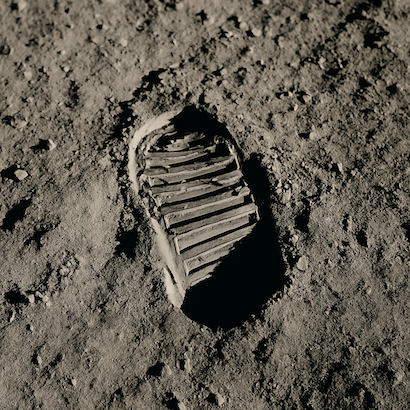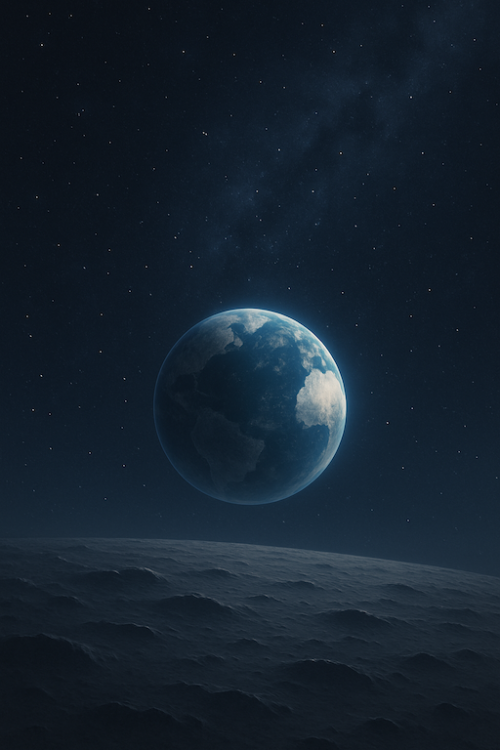It’s a “Wonder” Man Made It on the Moon — a Glimpse of Wonder entry™ — 3 of 5
The moon had always been distant — a cold companion admired from afar. Poets described it, farmers relied on it, and children pointed toward it from their backyards. But no one had ever touched it. Not until now.
Apollo 11 changed that. With fuel nearly spent and alarms flashing, the lunar module skimmed across the surface like a skipping stone. A boulder field loomed beneath them — ancient, cratered, uninviting. Neil Armstrong, calm and precise, scanned for a flat patch. Buzz Aldrin monitored fuel. Mission Control held its breath. When the call came — “Tranquility Base here, the Eagle has landed” — grown men exhaled for the first time in minutes. Some wept. Some prayed.
It wasn’t just an arrival — it was a crossing. A threshold had been breached. Man was no longer just looking at the moon. He was standing on it.
And yet, even there — on dust untouched by any life but Jehovah’s — the first human impulse was not to conquer. It was to marvel.
Before stepping outside, they paused for something surprisingly mundane: breakfast. The first food ever eaten on the moon? Bacon. Not the sizzling, pan-fried kind, but thermostabilized bacon squares, compact and cold. They weren’t fooling themselves — this wasn’t a picnic. But in its own quiet way, it grounded them. A familiar ritual in a place where nothing was familiar. And maybe that’s the beauty of it. One of mankind’s most extraordinary mornings… began with one of Earth’s most ordinary.
 Neil stepped down the ladder slowly. The world watched. More people witnessed that single step than had ever watched anything before. And with careful, poetic control, he said it: “That’s one small step for man, one giant leap for mankind.” But those watching didn’t feel triumphant. They felt hushed. Humbled. It was as if all of Earth had collectively whispered: We’re not alone.
Neil stepped down the ladder slowly. The world watched. More people witnessed that single step than had ever watched anything before. And with careful, poetic control, he said it: “That’s one small step for man, one giant leap for mankind.” But those watching didn’t feel triumphant. They felt hushed. Humbled. It was as if all of Earth had collectively whispered: We’re not alone.
The astronauts were far from casual tourists. Every movement was rehearsed. Every moment was borrowed from a thin window of breathable air and limited battery power. They were professionals — but even they couldn’t help pausing to admire the view. The moonscape was like a desert with no beginning, no wind, no color — just sharp shadows and silence. Aldrin called it “magnificent desolation.” Fitting.
From Earth, the moon had always seemed smooth. Up close, it was anything but. Craters, ridges, and powdery regolith covered everything. Lunar dust clung to suits like charcoal — fine as talc but unshakable. The American flag was planted — not to claim territory, but to signal: we made it. This happened.
And before resuming their checklist, Buzz took a moment to acknowledge the Creator. Not just the success of the mission — but the invisible framework that made it possible. Gravity, orbital mechanics, engine thrust, trajectories, pressure seals — none of it worked by chance. It all obeyed fixed laws — laws Jehovah Himself established when He formed the heavens and the earth. In that quiet moment, standing on another world, the overwhelming feeling wasn’t pride. It was gratitude. Reverence. A deep awareness that without the Creator’s precision, they never could have made it off the launch pad — let alone land on the moon.
Was Jehovah watching? Of course. As one astronaut later said: If I had blown out that window, I’d have been gone in a second. Death was an inch away. And yet — I felt no fear. I felt… awe.
Mission Control had their rules. Alarms had thresholds. Timers clicked down to fuel cutoffs. One minute longer, and Armstrong might have been ordered to abort. But he didn’t. Not out of rebellion — but because he saw what was ahead. A safe place. Just beyond the rocks. It took extra fuel to get there, but they made it. Just barely.
One of the team later admitted: We were 60 seconds from having to call it off. But we didn’t. He landed it.
He did — but only because Jehovah allowed it. The moon hadn’t changed. It was the same body suspended in space by God’s hand. And the Earth — seen now from the moon’s surface — hung silently in the blackness, vibrant and whole. A blue and white sphere, cradled by nothing. As Job described: He stretches out the northern sky over empty space, suspending the earth upon nothing (Job 26:7). Never had that scripture looked more literal.
Even scholars have acknowledged the verse as “a remarkable vision” — especially for its time. According to Awake! (October 22, 2001), the Bible’s image of the Earth suspended in space reflects an understanding far ahead of ancient science. And now, thanks to a few brave astronauts, we’ve actually seen it.
 And perhaps no photograph has ever captured humanity so completely as the one taken by astronaut Michael Collins, alone in lunar orbit while his crewmates walked below. From his vantage point, he looked back and framed the Earth in his lens. Other than himself, and the two men on the moon, every living person was in that shot — every country, every city, every life. It was a picture of home… and of just how small it really is.
And perhaps no photograph has ever captured humanity so completely as the one taken by astronaut Michael Collins, alone in lunar orbit while his crewmates walked below. From his vantage point, he looked back and framed the Earth in his lens. Other than himself, and the two men on the moon, every living person was in that shot — every country, every city, every life. It was a picture of home… and of just how small it really is.
And for a moment, humanity touched that nothing — and found it real.
Edited by dljbsp
- Roxessence and Dolce vita
-
 2
2

0 Comments
Recommended Comments
There are no comments to display.
Join the conversation with your brothers and sisters!
You are posting as a guest. If you are already a member, sign in now to post with your existing account.
Note: Your post will require moderator approval before it will be visible.